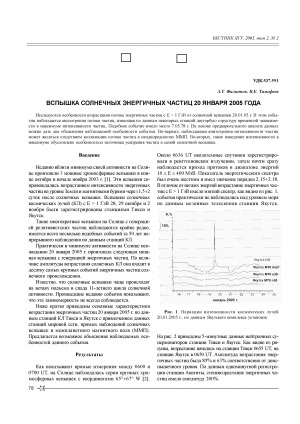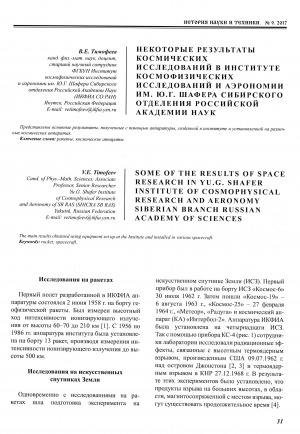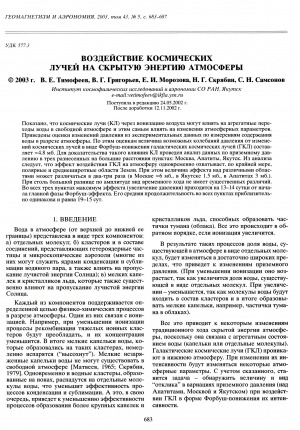Место работы автора, адрес/электронная почта: Институт космофизических исследований и аэрономии им. Ю.Г. Шафера СО РАН, Лаборатория космических лучей высоких энергий ; 677980, г. Якутск, пр. Ленина 31 ; e-mail: vetimofeev@ikfia.ysn.ru ; https://ikfia.ysn.ru/institute/staff/ikfia
Ученая степень, ученое звание: канд. физ.-мат. наук
Область научных интересов: Космические лучи.
ID Автора: РИНЦ AuthorID: 27732
Деятельность: С 1977 г. работает в Институте космофизических исследований и аэрономии им. Ю. Г. Шафера.
Количество страниц: 12 с.
Periodic 24-hour variations in the intensity of galactic cosmic rays, continuously observed by ground-based detectors, are called solar diurnal variations. The nature of these variations lies in the existence in the interplanetary medium of an anisotropic spatial distribution of galactic cosmic rays, which arises during the interaction of these particles with the heliosphere. It is believed that the physical factors responsible for the observed anisotropy of galactic cosmic rays are the processes of convection, diffusion and their drift. The combination of these factors determines the main parameters of solar diurnal variations, such as amplitude, phase and energy spectrum. To study the energy spectrum of solar-diurnal variations, we used measurement data from muon telescopes of the Yakutsk Cosmic Ray Spectrograph after A.I. Kuzmin and Nagoya stations (Japan). The research approach is based on the idea of the crossed telescope method, originally designed to take into account the temperature effect. Due to the difference in the receiving characteristics of the crossed northern and southern directions of the above muon telescopes, the intensity variations recorded by them are sensitive to changes in the energy spectrum of solar-diurnal variations. This property was used to assess the dynamics of the energy spectrum of solar-diurnal variations for 22-25 cycles of solar activity. Analysis of the data obtained showed that in the last minimum of solar activity in 2018-2021. An anomalously early phase of solar-diurnal variations was observed. To study this phenomenon, we simulated the ratio and phase difference of a pair of northern and southern crossed directions for both muon telescopes for different types and values of the energy spectrum of solar-diurnal variations. A comparison of model calculations and observational data has made it possible to establish that during periods of minimum solar activity in the positive polarity of the general magnetic field of the Sun, a significant softening of the energy spectrum of solar-diurnal variations is observed. The reasons for the discovered phenomenon are discussed.
Динамика энергетического спектра солнечно-суточных вариаций интенсивности космических лучей в 22–25 циклах солнечной активности / П. Ю. Гололобов, С. К. Герасимова, В. Г. Григорьев [и др.] ; Институт космофизических исследований и аэрономии им. Ю. Г. Шафера // Вестник Северо-Восточного федерального университета им. М. К. Аммосова. - 2024. - Т. 21, N 2 (96). - С. 46-57. - DOI: 10.25587/2222-5404-2024-21-2-46-57
DOI: 10.25587/2222-5404-2024-21-2-46-57
Количество страниц: 10 с.
Тимофеев В. Е. Космические лучи и динамика приземного давления / Тимофеев В. Е. // Оптические исследования высокоширотной верхней атмосферы : Всероссийская конференция, посвященная 40-летию оптических измерений на полигоне "Маймага", 20-23 августа 2019 г. Якутск-Маймага. – Якутск : Сфера, 2019. – С. 120-128.
Количество страниц: 4 с.
Peculiarities of the increase of E > 1 GeV particle flux with during on the solar flare on January 20, 2005 are studied. In this event the extreme anisotropy of particle flow has two peaks in the intensity maximum as in the case May E > 1 GeV 7 1978. On the basis of preliminary analysis of data one can explain the observed peculiarity of the event by two ways. Firstly, the anisotropy of particle intensity can be a consequence of collimation of particle flux in IMF magnetic inhomogeneties carried away by the solar wind. Secondly, such a behavior of intensity in maximum is caused by the peculiarity of particle acceleration source in the solar flare itself.
Филиппов, А. Т. Вспышка солнечных энергичных частиц 20 января 2005 года=Increase of the Solar Energetic Particle Flux on January 20, 2005 / А. Т. Филиппов, В. Е. Тимофеев // Вестник Якутского государственного университета им. М. К. Аммосова. – 2005. – Т. 2, N 2. – С. 78-80.
Издательство: ИКФИА СО РАН
Год выпуска: 2009
Количество страниц: 36 с.
Количество страниц: 4 с.
The main results obtained using equipment set up at the Institute and installed in various spacecraft.
Тимофеев, В. Е. Некоторые результаты космических исследований в Институте космофизических исследований и аэрономии имени Ю. Г. Шафера Сибирского отделения Российской академии наук / В. Е. Тимофеев // История науки и техники = History of Science and Engineering. – 2017. – N 9 : ФГБУН Институту космофизических исследований и аэрономии им. Ю. Г. Шафера Сибирского отделения Российской Академии Наук (ИКФИА СО РАН) 55 лет!. – С. 31-34.
Количество страниц: 5 с.
Воздействие космических лучей на скрытую энергию атмосферы / В. Е. Тимофеев, В. Г. Григорьев, Е. И. Морозова, Н. Г. Скрябин, С. Н. Самсонов // Геомагнетизм и аэрономия. – 2003. – Т. 43, N 5. – С. 683-687.





